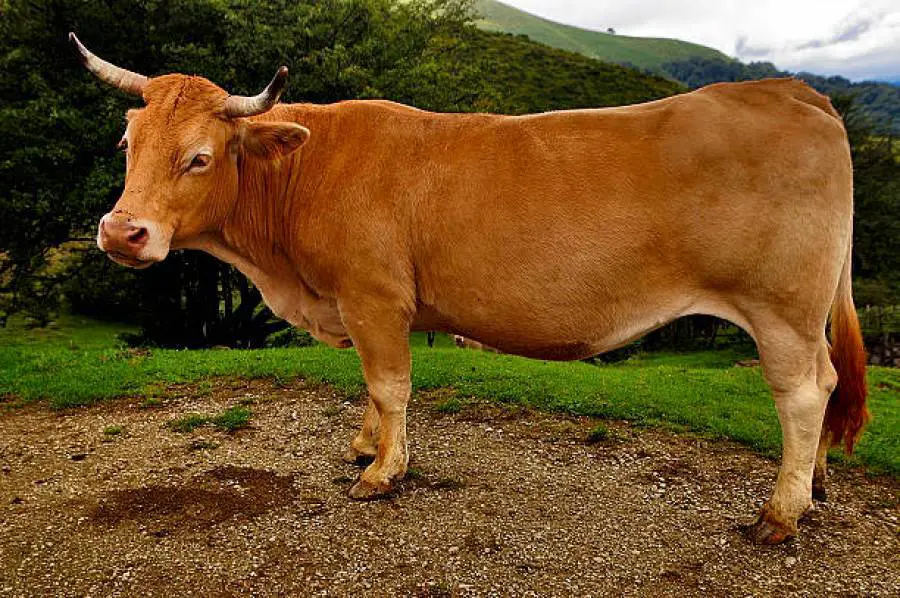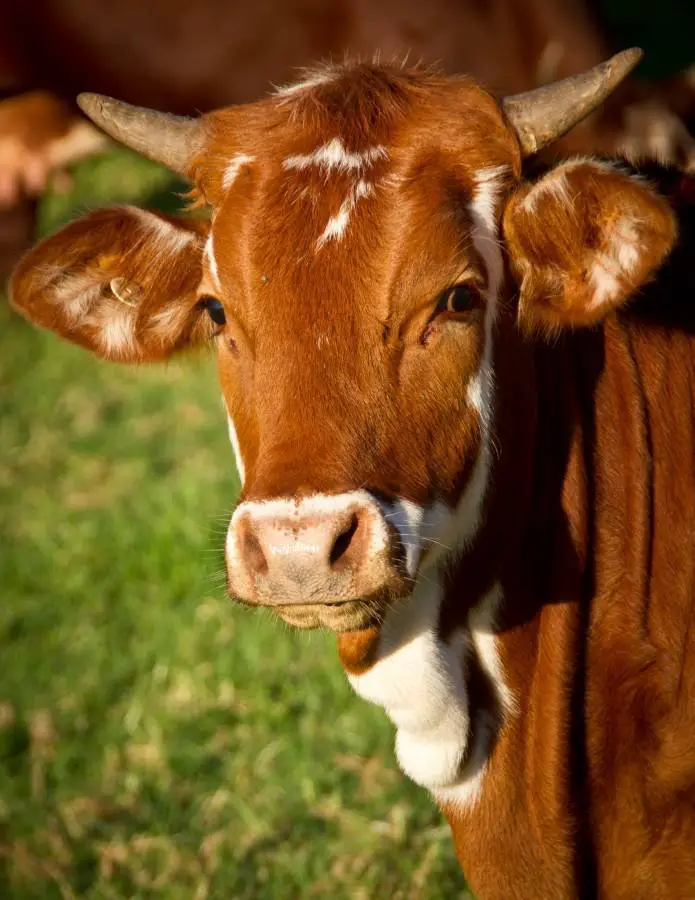Table of Contents
Gelbvieh cattle are some of the most famous cattle around the world. You will find them in several countries, including the United States.
Their yellow-brownish color is super attractive.
Gelbvieh cattle are up there as the oldest German cattle breeds. They were first found in the Franconian districts of Bavaria, south-east of Germany, in 1850.

They were a triple-purpose breed for milk and meat production, including draught animal experimentation.
If you’re looking to buy Gelbvieh cattle, you might want to get familiar with their advantages and disadvantages.
Hence, we’ve decided to describe their significant advantages and disadvantages.
Advantages Of Gelbvieh Cattle
As with every cattle breed globally, the Gelbvieh cattle have their advantages.
It ranges from their growth rate and maternal strengths to how well they can produce milk and meat.
Here are some of the main advantages of Gelbvieh cattle:
- Fast Growth Rate
- Strong Maternal Traits
- Exceptional Milking Ability
- Quiet Temperament Nature
- Quality Carcass Conformation
- Heat Tolerance and Tick Resistance
Fast Growth Rate
Gelbvieh cattle have a fast growth rate that makes them reach maturity early.
This fast growth rate results from their good muscling and low mature weight, making them very efficient.
They produce lower birth weight calves that start growing at a tremendous rate during reproduction.
The crossbred calves of Gelbvieh cattle are much heavier at weaning age than straight bred calves.
It is why breeders love to crossbreed Gelbvieh bulls with other female breeds.
The Benefit Of Fast Growth Rate
The fast growth rate in Gelbvieh cattle provides increased productivity and profit in ranching operations.
Producers will get to make more money within a shorter period.
The faster cattle grow, the better the chances of profitability for producers and ranchers.
Strong Maternal Traits
One of the main advantages of the Gelbvieh cattle breed is their maternal strength.
Gelbvieh cattle breed exhibits solid maternal traits such as high fertility, mothering instincts, shorter gestation period, smaller-bodied calf, and willingness of the cow to push during reproduction.
The Benefit Of Strong Maternal Traits
Strong maternal traits in Gelbvieh cattle are a breed characteristic that matters.
It results in the ability to reproduce a healthy calf, thereby making them suitable for use as terminal sires.
Gelbvieh cattle are good mothers, and calving is relatively easy and quick.
Exceptional Milking Ability
There are so many advantages of Gelbvieh cattle, but one that stands out is an exceptional milking ability. Thanks to their perfect udders and high feed efficiency.
This measure reveals that Gelbvieh cattle can turn feed nutrients into milk components quickly.
The udders of Gelbvieh cattle are pretty compact, and the teats are well-placed.
This excellent trait ensures the young calves of this breed reach weaning age at a marketable weight.
The Benefit Of Exceptional Milking Ability
Improved milking ability has increased the rate of milk production in the dairy farming industry.
Quiet Temperament Nature
Gelbvieh cattle are known to display a docile temperament nature. It means they are very submissive to breeders, producers, and processors.
Also, they are reticent and curious, making them ideal for farmers and ranchers alike.
They have a high docility score regarding safety requirements in meat production and crossbreeding programs.
Studies have shown that the average daily gain of cattle with a high docility score supersedes that of cattle with a more aggressive score.
The Benefit Of Quiet Temperament Nature
The quiet temperament nature of Gelbvieh cattle enhances overall profitability and success in meat production, crossbreeding programs, and commercial cattle operations.

Quality Carcass Conformation
Carcass conformation determines the quality of the meat. It results in the breed reaching marketable weight at a younger age than other breeds.
Also, their meat is tender and tasty.
The factors that enable this excellent muscle development in Gelbvieh cattle include:
- Early puberty age
- High weaning weight
- Excellent muscle development
The Benefit Of Quality Carcass Conformation
Excellent muscle development in Gelbvieh cattle results in high cutout yields, which helps producers increase meat production for the beef production industry.
Furthermore, it increases the rate of replacement heifers because they have structural soundness.
Heat Tolerance And Tick Resistance
The skin of Gelbvieh cattle has a specific tolerance to heat and parasites like deadly ticks.
Their skin is highly pigmented, which protects them from sun damage. Not just that, their skin is also highly resistant to ticks and parasites.
It is a great advantage to have.
The Benefit Of Heat Tolerance And Tick Resistance
The benefit is simple; contracting skin disease is highly reduced.
Disadvantages Of Gelbvieh Cattle
As good as the Gelbvieh cattle sounds, certain disadvantages are associated with the breed. These disadvantages are nothing out of the ordinary, so let’s look at them.
Here are some of the significant disadvantages of the Gelbvieh cattle:
- Highly Expensive Price
- High Maintenance Cost
- Polled Gelbvieh Calves
Highly Expensive Price
The price of Gelbvieh cattle varies based on availability, weight, and location. These factors make the pricing of Gelbvieh cattle end up at a higher cost.
If you live in a rare breed location, you will have to pay a huge price to get the calves for breeding.
In addition, the success level in crossbreeding Gelbvieh cattle means they are in high demand.
The Downside Of Highly Expensive Price
Since Gelbvieh cattle are in high demand, you will have to part with a lot of money to buy them.
High Maintenance Cost
The purity of the Gelbvieh cattle breed means they can be pretty challenging to maintain.
Breeders and ranchers spend a lot of productive time taking care of the herd. Negligence is not permitted.
If you own a pure breed, there are specific maintenance guidelines you need to follow strictly.
The Downside Of High Maintenance Cost
The high maintenance cost when breeding Gelbvieh cattle can lead to stress and loss of productive time.
This breed demands a lot of attention, thereby causing a severe headache.
Polled Gelbvieh Calves
These days, many Glebvieh calves are born polled. It means they don’t have horns.
Back in the day, cattle farmers dehorn Gelbvieh cattle.
This dehorning process requires a lot of effort that involves genetic mutation of the horned cattle breed not to develop horns.
In a way, some cattle farmers can choose to see positivity in this, but everyone can agree it’s a disadvantage because it can reduce the percentage of Gelbvieh traits in newborn calves.
The Downside Of Polled Gelbvieh Calves
Producers select more horned cattle in their breeding programs than polled cattle.
Furthermore, the future performance of polled calves can be affected because of the genetic sacrifices.
Conclusion
As you can see, the advantages of Gelbvieh cattle outweighs the disadvantages.
This cattle breed stands out because they combine an excellent growth rate with quality carcass formation.
Also, they have a lot to offer in the dairy farming industry because of their exceptional milking ability.
Cattle ranchers love this breed because they can quickly adapt to many rangelands and weather conditions.
They can even stay in a herd for a long time, providing longevity.
When it comes to crossbreeding, their beautiful color varieties and traits make them the best.
